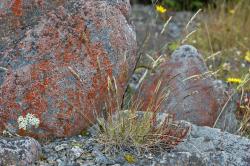- Taxon
- Gallery
Small tufts 2–35–(55) cm, with slender, often almost filiform culms usually » grey-green often involute leaves at maturity; branching extravaginal. Leaf-sheath 0.5–2 cm, glabrous, or sparsely finely prickle-toothed on ribs to densely pubescent. Ligule 0.2–1 mm, truncate or rounded, ciliate. Leaf-blade 1–12–(18) cm × 0.3–1.5–(2) mm, abaxially glabrous to finely scabrid to pubescent, sometimes with scattered long hairs, adaxially ribbed, minutely scabrid to shortly pubescent; margins minutely prickle-toothed, occasionally with scattered long hairs. Culm (1)–2–20–(45) cm, internodes glabrous, or sometimes densely pubescent with ascending or tangled spreading hairs, occasionally hairs retrorse below. Panicle 0.5–8.5 × 0.5–1.2 cm, ± spike-like with very short close-set branches but rachis visible, or more open with short ascending branches; rachis glabrous and branches with a few minute prickle-teeth, or rachis and branches pubescent. Spikelets (3.5)–4–5.5 mm, pale green or red-tinged. Glumes subequal, membranous, keels with prickle-teeth in upper ⅓ to upper ½; lower ≤ upper, elliptic, very rarely oblong-lanceolate, upper ≤ spikelet, broadly elliptic; margins with very minute prickle-teeth near obtuse to acute rarely almost mucronate tip. Lemma 3.5–5 mm, minutely bidentate, papillose, minutely scabrid near keel; awn 2–3–(4) mm, insertion in upper ¼ of lemma. Palea minutely prickle-toothed on keels except near base and sparsely minutely prickle-toothed on margins. Callus hairs 0.2 mm. Rachilla hairs few, to 0.8 mm. Lodicules c. 0.7 mm, glabrous. Anthers 0.6–1.3 mm. Gynoecium: ovary c. 0.7 mm; stigma-styles c. 1.2 mm. Caryopsis c. 2 × 0.5 mm.
[From: Edgar and Connor (2000) Flora of New Zealand. Volume 5 (second printing).]




